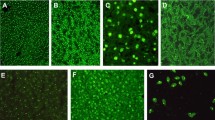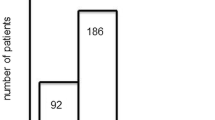Abstract
Antibodies to asialoglycoprotein receptor have diagnostic specificity for autoimmune hepatitis, but it is uncertain if they are complementary or redundant markers of the disease. Our aims were to assess their frequency and significance in type 1 autoimmune hepatitis and determine their contribution to the evaluation of these patients. Sear from 54 well-characterized patients were evaluated for antibodies to asialoglycoprotein receptor by a radioimmunofiltration assay based on rabbit-derived protein. Forty-four patients (82%) were seropositive. Seropositive patients were distinguished from seronegative counterparts by having higher serum gamma globulin (3.7±0.2 g/dl vs 2.3±0.3 g/dl,P=0.0007) and immunoglobulin G levels (3707±179 mg/dl vs 2203±263 mg/dl,P=0.0005) at presentation and a greater frequency of relapse after drug withdrawal (88% vs 33%,P=0.01). Seropositivity for smooth muscle and/or antinuclear antibodies did not define treatment outcomes and antinuclear antibodies occurred less frequently than the other markers. Concurrent testing for antibodies to asialoglycoprotein receptor and smooth muscle identified all patients. We conclude that antibodies to asialoglycoprotein receptor are common in type 1 autoimmune hepatitis and they identify patients with a high frequency of relapse after corticosteroid withdrawal. Concurrent testing for these antibodies and smooth muscle antibodies has the same diagnostic sensitivity as testing for antinuclear and smooth muscle antibodies but a greater prognostic implication.
Similar content being viewed by others
References
Czaja AJ: Natural history, clinical features, and treatment of autoimmune hepatitis. Semin Liver Dis 4:1–12, 1984
Czaja AJ: Autoimmune hepatitis: Evolving concepts and treatment strategies. Dig Dis Sci 40:435–456, 1995
Johnson PJ, McFarlane IG, Alvarez F, Bianchi FB, Bianchi L, Burroughs A, Chapman RW, Czaja AJ, Desmet V, Eddleston ALWF, Gerber MA, Hoofnagle JH, Kakumu S, MacSween RNM, Maddrey WC, Manns MP, Meyer zum Buschenfelde K-H, Mieli-Vergani G, Portmann BC, Reed WD, Schalm SW, Scheuer PJ, Toda G, Tsuji T, Tygstrup N, Vergani D, Zeniya M: Meeting report. International Autoimmune Hepatitis Group. Hepatology 18:998–1005, 1993
Desmet VJ, Gerber M, Hoofnagle JH, Manns M, Scheuer PJ: Classification of chronic hepatitis: Diagnosis, grading and staging. Hepatology 19:1513–1520, 1994
International Working Party: Terminology of chronic hepatitis. Am J Gastroenterol 90:181–189, 1995
Czaja AJ: Autoimmune chronic active hepatitis-a specific entity? The negative argument. J Gastro-Hepatol 5:343–351, 1990
Czaja AJ: Chronic active hepatitis: The challenge for a new nomenclature. Ann Intern Med 119:510–517, 1993
Czaja AJ, Manns MP: The validity and importance of subtypes of autoimmune hepatitis: A point of view. Am J Gastroenterol 90:1206–1211, 1995
Homberg J-C, Abuaf N, Bernard O, Islam S, Alvarez F, Khalil SH, Poupon R, Darnis F, Levy V-G, Grippon P, Opolon P, Bernuau J, Benhamou J-P, Alagille D: Chronic active hepatitis associated with antiliver/kidney microsome antibody type 1: A second type of “autoimmune” hepatitis. Hepatology 7:1333–1339, 1987
Manns M, Gerken G, Kyriatsoulis A, Staritz M, Meyer zum Buschenfelde K-H: Characterization of a new subgroup of autoimmune chronic active hepatitis by autoantibodies against a soluble liver antigen. Lancet 1:292–294, 1987
Stechemesser E, Klein R, Berg PA: Characterization and clinical relevance of liver-pancreas antibodies in autoimmune hepatitis. Hepatology 18:1–9, 1993
Czaja AJ, Carpenter HA, Manns MP: Antibodies to soluble liver antigen, P450IID6, and mitochondrial complexes in chronic hepatitis. Gastroenterology 105:1522–1528, 1993
Czaja AJ, Manns MP, Homburger HA: Frequency and significance of antibodies to liver/kidney microsome type 1 in adults with chronic active hepatitis. Gastroenterology 103:1290–1295, 1992
Czaja AJ, Davis GL, Ludwig J, Baggenstoss AH, Taswell HF: Autoimmune features as determinants of prognosis in steroid-treated chronic active hepatitis of uncertain etiology. Gastroenterology 85:713–717, 1983
Czaja AJ, Carpenter HA, Santrach PJ, Moore SB: Immunologic features and HLA associations in chronic viral hepatitis. Gastroenterology 108:157–164, 1995
Clifford BD, Donahue D, Smith L, Cable E, Luttig B, Manns M, Bonkovsky HL: High prevalence of serological markers of autoimmunity in patients with chronic hepatitis C. Hepatology 21:613–619, 1995
Tan EM, Chan EKL, Sullivan KF, Rubin RL: Antinuclear antibodies (ANAs): Diagnostically specific immune markers and clues toward the understanding of systemic autoimmunity. Clin Immunol Immunopathol 47:121–141, 1988
Tan EM: Antinuclear antibodies. Diagnostic markers for autoimmune diseases and probes for cell biology. Adv Immunol 44:93–151, 1989
Toh B-H: Smooth muscle autoantibody and autoantigens. Clin Exp Immunol 38:621–628, 1979
Czaja AJ, Nishioka M, Morshed SA, Hachiya T: Patterns of nuclear immunofluorescence and reactivities to recombinant nuclear antigens in autoimmune hepatitis. Gastroenterology 107:200–207, 1994
Czaja AJ, Ming C, Shirai M, Nishioka M: Frequency and significance of antibodies to histones in autoimmune hepatitis. J Hepatol 23:32–38, 1995
Dighiero G, Lymberi P, Monot C, Abuaf N: Sera with high levels of anti-smooth muscle and anti-mitochondrial antibodies frequently bind to cytoskeletal proteins. Clin Exp Immunol 82:52–56, 1990
Treichel U, Poralla T, Hess G, Manns M, Meyer zum Buschenfelde K-H: Autoantibodies to human asialoglycoprotein receptor in autoimmune-type chronic hepatitis. Hepatology 11:606–612, 1990
Poralla T, Treichel U, Lohr H, Fleischer B: The asialoglycoprotein receptor as target structure in autoimmune liver diseases. Semin Liver Dis 11:215–222, 1991
Treichel U, Gerken G, Rossol S, Rotthauwe HW, Meyer zum Buschenfelde K-H, Poralla T: Autoantibodies against the human asialoglycoprotein receptor: Effects of therapy in autoimmune and virus-induced chronic active hepatitis. J Hepatol 19:55–63, 1993
Treichel U, McFarlane BM, Seki T, Krawitt EL, Alessi N, Stickel F, McFarlane IG, Kiyosawa K, Furuta S, Freni MA, Gerken G, Meyer zum Buschenfelde K-H: Demographics of anti-asialoglycoprotein receptor autoantibodies in autoimmune hepatitis. Gastroenterology 107:799–804, 1994
McFarlane BM, Sipos J, Gove CD, McFarlane IG, Williams R: Antibodies against the hepatic asialoglycoprotein receptor perfused in situ perferentially attach to periportal liver cell in the rat. Hepatology 11:408–415, 1990
Vento S, Hegarty JE, Bottazzo G, Macchia E, Williams R, Eddleston ALWF: Antigen specific suppressor cell function in autoimmune chronic active hepatitis. Lancet 1:1200–1204, 1984
O'Brien CJ, Vento S, Donaldson PT, McSorley CG, McFarlane IG, Williams R, Eddleston ALWF: Cell-mediated immunity and suppressor-T-cell defects to liver-derived antigens in families of patients with autoimmune chronic active hepatitis. Lancet 1:350–353, 1986
Vento S, O'Brien CJ, McFarlane IG, Williams R, Eddleston ALWF: T-cell inducers of suppressor lymphocytes control liver-directed autoreactivity. Lancet 1:886–888, 1987
Lohr H, Treichel U, Poralla T, Manns M, Meyer zum Buschenfelde K-H, Fleischer B: The human hepatic asialoglycoprotein receptor is a target for liver-infiltrating T cells in autoimmune chronic active hepatitis and primary biliary cirrhosis. Hepatology 12:1314–1320, 1990
Lohr H, Treichel U, Poralla T, Manns M, Meyer zum Buschenfelde K-H, Fleischer B: Liver-infiltrating T helper cells stimulate the production of autoantibodies against the human asialoglycoprotein receptor in autoimmune chronic active hepatitis in vitro. Clin Exp Immunol 88:45–49, 1992
DiMagno EP, Corle D, O'Brien JF, Masnyk IJ, Go VLW, Aamodt R: Effect of long-term freezer storage, thawing, and refreezing on selected constituents of serum. Mayo Clin Proc 64:1226–1234, 1989
Czaja AJ, Carpenter HA: Sensitivity, specificity and predictability of biopsy interpretations in chronic hepatitis. Gastroenterology 105:1824–1832, 1993
Czaja AJ: Autoimmune hepatitis: current therapeutic concepts. Clin Immunother 1:413–429, 1994
McFarlane BM, McSorley CG, McFarlane IG, Williams R: A radioimmunoassay for detection of circulating antibodies reacting with the hepatic asialoglycoprotein receptor protein. J Immunol Methods 77:219–228, 1985
McFarlane IG, Hegarty JE, McSorley CG, McFarlane BM, Williams R: Antibodies to liver-specific protein predict outcome of treatment withdrawal in autoimmune chronic active hepatitis. Lancet 2:954–956, 1984
McFarlane IG, McFarlane BM, Major GN, Tolley P, Williams R: Identification of the hepatic asialo-glycoprotein receptor (hepatic lectin) as a component of liver specific membrane lipoprotein (LSP). Clin Exp Immunol 55:347–354, 1984
McFarlane BM, McSorley CG, Vergani D, McFarlane IG, Williams R: Serum autoantibodies reacting with the hepatic asialoglycoprotein receptor protein (hepatic lectin) in acute and chronic liver diseases. J Hepatol 3:196–205, 1986
McFarlane IG, Smith HM, Johnson PJ, Bray GP, Vergani D, Williams R: Hepatitis C virus antibodies in chronic active hepatitis: pathogenetic factor or false-positive result? Lancet 335:754–757, 1990
Esteban JI, Esteban R, Viladomiu L, Lopez-Talavera JC, Gonzalez A, Hernandez JM, Roget M, Vargas V, Guardia J, Houghton M, Choo Q-L, Kuo G: Hepatitis C virus antibodies among risk groups in Spain. Lancet 2:294–297, 1989
Soloway RD, Summerskill WHJ, Baggenstoss AH, Schoenfield LJ: “Lupoid” hepatitis, a nonentity in the spectrum of chronic active liver disease. Gastroenterology 63:458–465, 1972
Author information
Authors and Affiliations
Rights and permissions
About this article
Cite this article
Czaja, A.J., Pfeifer, K.D., Decker, R.H. et al. Frequency and significance of antibodies to asialoglycoprotein receptor in type 1 autoimmune hepatitis. Digest Dis Sci 41, 1733–1740 (1996). https://doi.org/10.1007/BF02088738
Received:
Accepted:
Issue Date:
DOI: https://doi.org/10.1007/BF02088738




